For me, the joy of riding is that mind-meld that happens when my horse and I are in sync and communication flows between us with subtlety and nuance. To achieve this, not only do I have to listen to and understand what Tonka is saying, but he has to understand me. I have to ride with clarity, and be fair in what I ask for. It takes observation, practice, athleticism, focus and hard work. Becoming a centaur is a lifelong endeavor.
It gets even more challenging when you’re aiming for an advanced level of movement, whether it’s jumping a course, or doing a dressage test, or traversing wilderness. Those challenges require the horse to work as hard as you are, and to buy into the endeavor. You can force a horse to do any of those things, but although that gets the activity done, you don’t have true collaboration.
Don’t we all say that we like being with our animals because they live in the moment? And yet when we’re training, we seem to forget that. We get what we want and then push for bigger and better. So often, when watching dressage lessons, I see the trainer tell the rider that’s it! but there’s no living in that good moment. Instead, the rider wants another, and taps the horse with the whip to get more. The rider might say good girl, but it’s followed by that whip. All the horse hears is Not enough, work harder! The horse has no incentive to keep going, and has no desire to buy into the conversation.The horse is overwhelmed by trying to figure out how to avoid the pressure that the rider applies – by whip, by spur, by leg, by seat, there are so many ways to get compliance.
The starting point to a true partnership is actually quite simple. Say thank you to your horse, and do it often. Saying thank you is a paradigm shift. There are so many ways to do it when riding.
The most obvious thank you is to stop and give your horse a cookie.
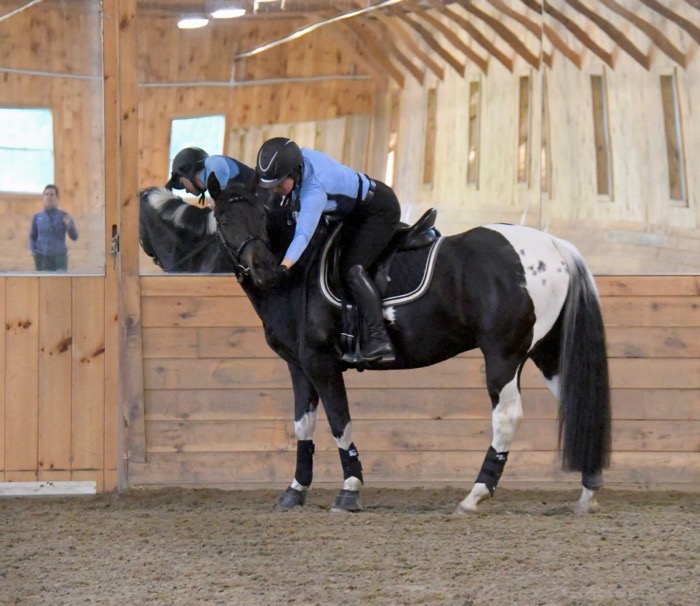
Or, you can say good boy! and give him a break, so that Good boy actually means something. Here Tonka has done a couple of strides of shoulder-in at the desired energy and angle, and he gets a clear, positive, response.
For some exercises, the reward can be to allow the free flow of movement. As Tonka becomes stronger and more athletic, riding quietly and letting him surge forward is reinforcing to him. In this clip you can see that I slowed Tonka with a half-halt to balance him, then let him go at the pace that he wanted. Tonka is a little behind the vertical and forehand heavy, but this is the first step to better movement. If I waited to reward until I got the end goal, we’d both be frustrated and exhausted!
If your riding entails keeping the horse in an upright, collected frame, a thank you can be going into a stretch. Here Tonka goes from a working to a stretch trot. (Note how his tail swings as he trots. That’s a clear indication of a relaxed and confident horse.)
You can make that communication more precise by using an “event marker” to tell the horse exactly the moment that they got right. In this video, my trainer clicks at the instant that Tonka gives us a balanced downward transition from trot to walk. In previous attempts, Tonka had hollowed his back and shortened how he went with his rear legs. In this one he stayed strong through the top line. It’s worth a click and a cookie!
Sometimes, simply showing appreciation and affection makes the entire ride better for your horse. I love this series of photos. Kim and I are discussing the exercise that I just did. We’re giving Tonka a break as we talk.
I pat him.
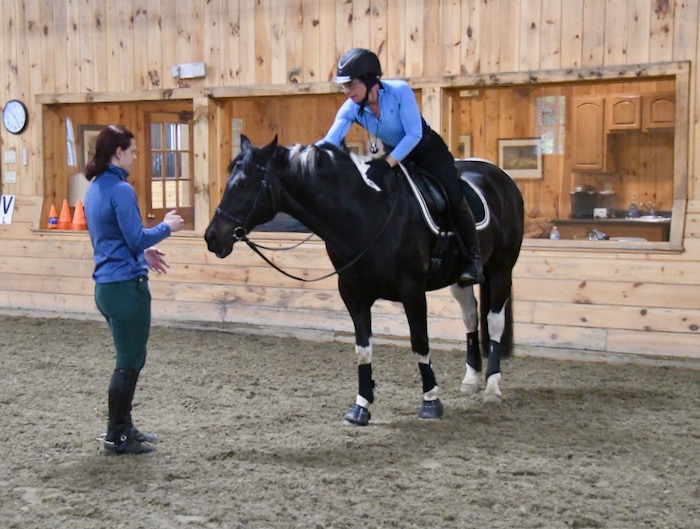
Tonka says that’s not enough and wants some attention from Kim.

Message received and acted on. He loves forehead scratches.
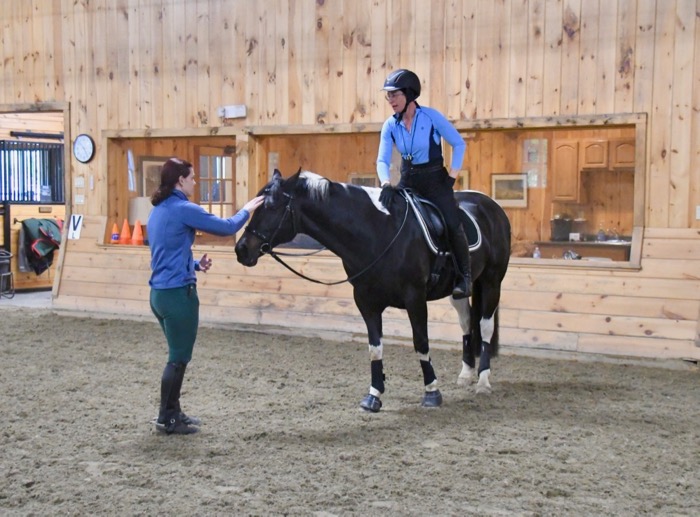
Finally, the biggest thank you is to know when to end the training session. Yesterday I trailered to take a lesson from Kim. We did a lot of canter to trot to canter serpentines. Tonka was working willingly and moving beautifully. (It’s new for him to be this engaged and balanced in a corner.)
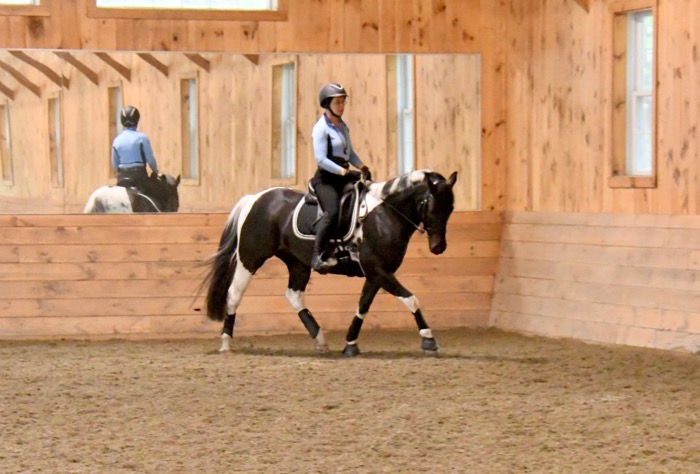
I paid for a 45 minute lesson. We stopped after a half-hour. It was time and money well-spent.
I do this at home, too. I call it a day when we’re both still feeling good. I say thank you, and we go for a walk.
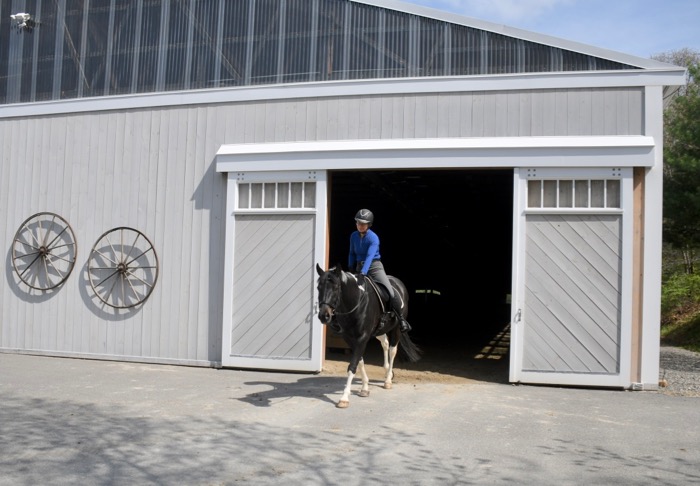
How do you thank your horse when you’re riding?
Note: if you’ve liked this post, please share with others. Easy to use buttons are below. Also, the best way to not miss a post is to subscribe. Button at the right. Don’t rely on FaceBook – my posts won’t always end up in your feed. Thank you!


Since I mostly trail ride, I say thank you by getting off occasionally, loosening the chinch a little, and giving them a break. Depending on how far I am riding I may carry some apples or carrots for them at break time. Then when we get back to the trailer they get a good brushing and a treat.
One of my horses is a rescue horse, so maybe that is thanks enough for her!!!!
That sounds just right. Do you let them graze? Or don’t want to let them think that’s an option?
I do let them graze if there is any grass anywhere.
Great post, thanks. The videos are really helpful to illustrate what you are talking about.
Well written!!! I find a scratch on the side of the withers with my inside hand especially helpful during schooling or out on the trail. It also has the added benefit of relaxing the neck.
Well engaged shoulder-in, a quick thank you scratch and continue on. Walking by a scary kid toy on the side of the road, a double thank you scratch. And best of all easy to sneak in during a test or on course during a show.
Glad you mentioned that! The added benefit of a scratch is that the rider relaxes and softens their hands for a moment, too.
This is so lovely , very clear with you asking and he acknowledges with calmness ..and willingness to go forward. thank you ….. So great learning for all.
Writers need thank-yous, too! I appreciated your comment.
I am asking my coach to let me know when Miss Dancer “gets it” because I don’t always feel it. Then I can learn what the feel is and she (Miss Dancer) also learns and feels appreciated instead of always having to deal with my unlearned cues and reactions. We are both learning at the same time and I find it helps reduce her resistance and our frustration.
Absolutely. Learning “feel” is best done when there’s someone on the ground saying “there!”
I love everything about this post!!! Thank you so much for your insights (and the great video clips/pics) xx